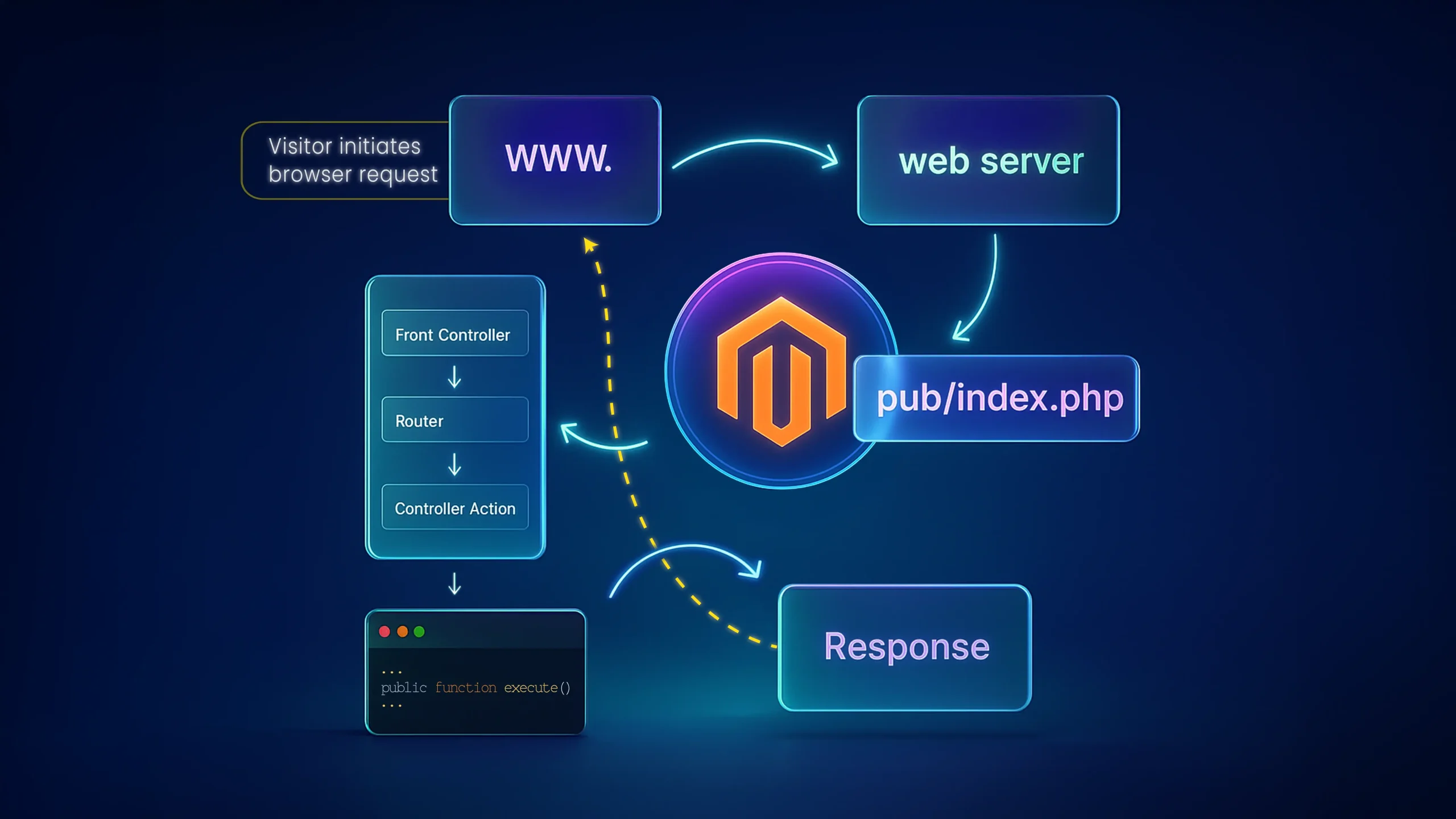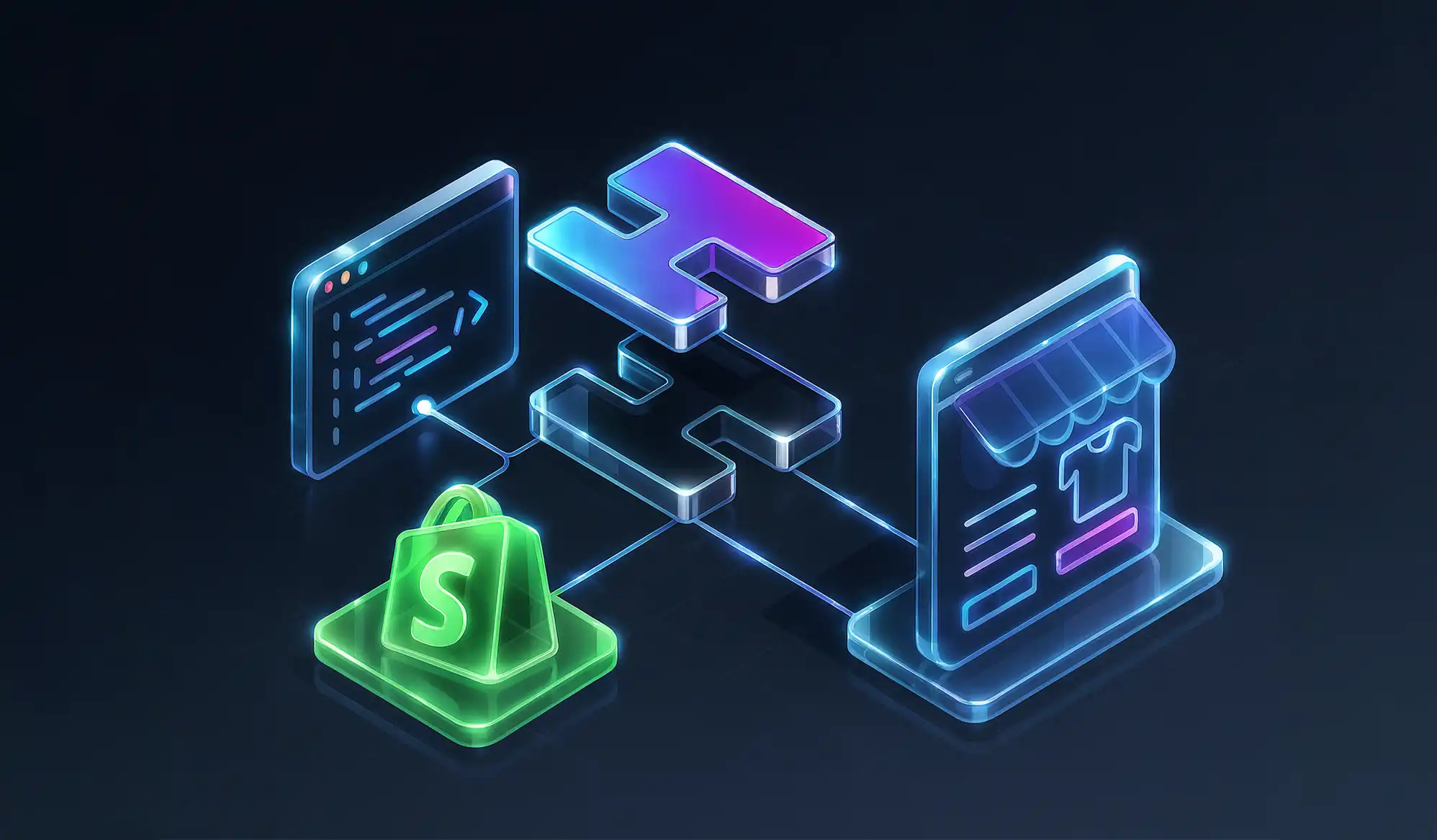- Every request starts at index.php and flows through Magento’s central front controller.
- Routers map URL segments to specific controller classes and execute matching actions.
- Controllers return Result objects to cleanly separate logic from rendering responsibilities.
- Layouts are built from XML handles, blocks, and templates during page generation.
- Plugins and observers allow safe customization without touching core Magento code.
- Understanding this flow helps build, debug, and scale Magento applications more effectively.
Magento 2 is impressive, but as soon as you try to backtrace what happens when a request hits your store, that’s when you start to spiral into numerous class references, dependencies, and XML files. If you have ever tried to step through a stack trace to find out why something is loading or how Magento has chosen a specific controller, you are not alone.
The request-response lifecycle is essentially Magento 2’s central nervous system. This is how every frontend and backend page loads; how every AJAX call works; and how you interact with the system via APIs. It’s not just some academic exercise; knowing this flow helps you write better modules, avoids you from overriding core functionality, and helps you extend functionality the right way.
In this article, we will go through Magento 2’s request lifecycle, from the very beginning to the end. We will look at a single request from the browser to the server; into Magento’s internals; or through routers and controllers; and finally back out as a response.
Why Understanding the Request Lifecycle Matters
Before we get technical, here’s the bigger picture. Knowing the request lifecycle helps you:
- Customize behaviors more safely (no more hacking core files)
- Debug faster when something breaks
- Write cleaner, more efficient modules
- Extend Magento the Magento way
Let’s now walk through the journey of a single request as it travels through Magento 2.
1. It All Starts with index.php
The index.php file in the root of the Magento installation is where all requests to Magento 2 begin. This file is the front controller entry point that passes the request off to the core machinery of Magento.
Here’s the actual code:
require __DIR__ . ‘/../app/bootstrap.php’;
$bootstrap = \Magento\Framework\App\Bootstrap::create(BP, $params);
$bootstrap->run($bootstrap->createApplication(\Magento\Framework\App\Http::class));
Let’s break that down:
- The bootstrap.php file initializes Magento’s environment.
- It sets up error reporting, loads configuration, and gets everything ready.
- The Bootstrap::create() method sets up dependency injection, configuration, and object management.
- Finally, the application (in most cases, App\Http) is created and run.
But don’t be fooled by the simplicity. This kicks off a deep and layered flow of logic inside Magento.
Area Codes
Magento doesn’t treat every request the same. Behind the scenes, it uses area codes like frontend, adminhtml, and webapi_rest to define the context.
The area code tells Magento which configuration, layout, and DI rules to load. Without it, nothing works. CLI commands or background scripts often fail with:
“Area code is not set”
That’s why developers usually add:
$this->state->setAreaCode(‘adminhtml’);
The area code sets the stage for everything that follows.
2. The Application Object and Front Controller
Once the application is created, Magento delegates request handling to the Front Controller. It implements \Magento\Framework\App\FrontControllerInterface. The class it uses by default is:
\Magento\Framework\App\FrontController
Its job is to:
- Identify which router should handle the request
- Pass the request along to the selected router
- Let that router assign a controller
In Magento, routers are like categories of routes. There are three main router types:
- Admin router for backend URLs
- Standard router for frontend
- Default router as a fallback
Each router checks whether it should handle the request and if so, returns a matching controller.
3. Routing the Request
Routing is where the Magento magic starts to feel like controlled chaos, but in reality, it follows a clearly defined process.
Magento uses the router pool, which is injected into the Front Controller. Each router in this pool is checked based on a defined sort order, not randomly. Magento goes through each router one by one and tries to match the incoming request path.
Here’s how the matching flow looks:
- The router retrieves the requested path, for example: /customer/account/login
- It compares that path against its configured routes
- If no match is found in the current routers, Magento checks the routes defined by modules via their routes.xml files
- If the route isn’t found in any module either, Magento finally routes the request to the no-route handler, which displays a 404 page
Let’s say the URL is /customer/account/login. Magento looks for a route in the format:
<router_id>/<controller_name>/<action_name>
Which would translate to:
- Router ID: customer
- Controller: account
- Action: login
Magento then looks for the class:
\Magento\Customer\Controller\Account\Login
If the class and method are valid, then Magento will instantiate the controller and set up the execute() method for execution.
Controller Dispatch Events
Just before Magento calls a controller’s execute() method, it fires a couple of key events: controller_action_predispatch and controller_action_dispatch.
These act like early checkpoints in the request cycle. If you need to log a request, check authentication, or redirect a user before the controller does anything. This is where you hook in.
They can also be scoped down to specific controllers, like:
controller_action_predispatch_customer_account_login
Which gives you precision without rewriting core logic.
4. Dependency Injection
Magento will use its Object Manager to instantiate and inject the dependencies for the controller before any controller is executed.
Those who have written any kind of custom modules must have faced constructors that looked something like this:
public function __construct(
\Magento\Framework\View\Result\PageFactory $resultPageFactory
) {
$this->resultPageFactory = $resultPageFactory;
}
Magento will use a Dependency Injection (DI) container to fix those dependencies without any manual intervention. This container reads from:
- di.xml files
- Factories and proxies
- Shared and non-shared object scopes
This makes sure that instead of rewriting base classes, the core behavior is overridden in a modular and clean way.
5. The Controller Executes
When Magento constructs the controller and injects its dependencies, it proceeds to execute the execute() method.
Here is an example:
namespace Magento\Customer\Controller\Account;
class Login extends \Magento\Framework\App\Action\Action
{
public function execute()
{
// Do login logic
}
}
This is where the actual business logic happens:
- Retrieve request data
- Validate user input
- Load models
- Prepare result objects
Magento’s controllers return a Result object, not a raw response. This helps separate business logic from the rendering logic.
Common result types include:
- ResultPage for full pages
- ResultRedirect for redirects
- ResultJson for AJAX
6. Building the Response
After a result object is returned by the controller, it is used by Magento to create the HTTP response.
For example, a ResultPage object tells Magento to:
- Load layout XML
- Assemble blocks
- Render HTML content
The result object implements \Magento\Framework\Controller\ResultInterface, which defines how it renders the output.
If you’re returning a page, the rendering involves layout handles, templates (.phtml), blocks, and view models. If it’s a redirect or JSON response, Magento formats the output accordingly and sends it back through the HTTP response object.
7. Sending the Response to the Browser
Finally, the response gets passed back through the App\Http object to the browser along with the headers, session data, cookies, and content.
Then the output is rendered by the browser, completing the request lifecycle. But do not get tricked by the simplicity of this final step. By now, Magento has:
- Bootstrapped the framework
- Routed and matched a controller
- Built and injected dependencies
- Executed business logic
- Assembled the response
8. Layout Generation and Rendering
Once the controller has done its job and returned a ResultPage, Magento takes over to build the view layer. This involves layout XML and block classes.
Internally, Magento uses layout handles to know what blocks and templates to load. For example, if the product page is being displayed, Magento might use handles such as:
- default
- catalog_product_view
- catalog_product_view_type_simple
Each handle points to one or more XML layout files located in view/frontend/layout/.
These layout files define:
- Which blocks to render
- Which templates to include
- The structure of the page (head, header, footer, main content)
Example XML snippet:
<page xmlns:xsi=”http://www.w3.org/2001/XMLSchema-instance” layout=”1column”>
<body>
<referenceContainer name=”content”>
<block class=”Magento\Catalog\Block\Product\View” name=”product.info” template=”Magento_Catalog::product/view.phtml”/>
</referenceContainer>
</body>
</page>
The XML layout file instructs Magento to place a block in the content area of the page and use a specific.phtml template to render it. Once parsed, Magento creates a block tree, in which each node associates with a PHP class and a corresponding template. These blocks get rendered recursively to generate the final HTML.
9. Role of Blocks and Templates
In Magento, all blocks are the extensions of the \Magento\Framework\View\Element\AbstractBlock. Each one can contain:
- Business logic
- Template variables
- Child blocks
The .phtml templates associated with blocks are plain PHP files—this is where the actual HTML is written.
Example: If you’re rendering a product’s price, the template might include:
<?php echo $block->getProduct()->getFinalPrice(); ?>
Magento utilizes the block to transport data and logic to the template allowing the template to remain presentation focused.
And don’t forget this is layered on the layout structure previously defined. It’s a highly integrated system, but one that gives you immense flexibility.
Full Page and Block Caching
Magento doesn’t rebuild every page from scratch. If Full Page Cache (FPC) is enabled, Magento can serve a complete page from cache, bypassing layout building entirely.
But FPC only works when the content is the same for everyone. That’s why it skips logged-in users, cart pages, and other dynamic sections.
For blocks, caching is more granular. You can make a block cacheable by adding:
<block … cacheable=”true” />
and overriding getCacheKeyInfo() in your block class.
If you leverage it properly, caching can shave seconds off page loads.
10. Plugins: Intercepting Behavior Without Hacking Core
One of Magento 2’s biggest architectural improvements over Magento 1 is its use of interceptors, commonly known as plugins.
Plugins let you hook into any public method of a class without rewriting it or extending it directly. There are three types of plugin methods:
- before: Runs before the original method
- around: Wraps the original method (you decide whether it runs or not)
- after: Runs after the original method and can modify its result
Example di.xml plugin registration:
<type name=”Magento\Catalog\Model\Product”>
<plugin name=”custom_price_plugin” type=”Vendor\Module\Plugin\ProductPricePlugin” />
</type>
And here’s a corresponding plugin class:
class ProductPricePlugin
{
public function afterGetFinalPrice($subject, $result)
{
return $result * 0.9; // Apply 10% discount
}
}
This plugin applies a discount after Magento calculates the product price. No core overrides. Clean and upgrade-safe.
Behind the scenes, Magento generates a proxy class that merges your plugin into the call stack. It’s automatic and elegant—and very powerful when used responsibly.
11. Observers and Events: Reacting to System Activity
A robust event/observer system is leveraged by Magento 2 in order to establish clear communication among modules without tight coupling.
There are two types of events:
- Global events: Triggered anywhere in the app
- Area-specific events: Limited to frontend, adminhtml, or webapi
Magento dispatches an event like this:
$this->_eventManager->dispatch(‘checkout_cart_add_product_complete’, [‘product’ => $product]);
You can listen to that event using events.xml:
<event name=”checkout_cart_add_product_complete”>
<observer name=”log_product_addition” instance=”Vendor\Module\Observer\LogAddObserver” />
</event>
Your observer class might look like this:
class LogAddObserver implements \Magento\Framework\Event\ObserverInterface
{
public function execute(\Magento\Framework\Event\Observer $observer)
{
$product = $observer->getEvent()->getProduct();
// Log or trigger other actions
}
}
This system is perfect for things like logging, sending emails, triggering APIs, and custom tracking, without touching core logic.
12. REST & GraphQL Flow
REST and GraphQL requests don’t follow the exact same path as frontend pages, but they run through Magento’s lifecycle just the same. REST uses its own controller (\Magento\Webapi\Controller\Rest), matching endpoints from webapi.xml.
GraphQL routes every request to a single endpoint (/graphql) and handles it dynamically via resolvers. There’s no layout or HTML here. But routing, dependency injection, plugins, and event observers? All still in play.
13. The Full Lifecycle Summary
Let’s piece it all together. A typical request in Magento 2 flows like this:
- index.php: Initializes the app and loads dependencies
- Bootstrap: Sets up DI container, environment, and services
- Front Controller: Delegates to the right router
- Router: Matches the URL to a controller
- Controller: Runs business logic and returns a corresponding result object
- Result Object: Defines the response format, like HTML, JSON, etc.
- Layout XML + Blocks: Builds the page structure
- Templates: Render the final HTML
- Plugins + Observers: Inject dynamic behavior throughout
- Response Object: Delivers the final output to the browser for rendering
At first, it may seem like a complex, layered system. But with a proper understanding of the flow, you can find each layer highly extendable, modular, and predictable.
Final Thoughts
The request-response lifecycle of Magento 2 may seem overly complicated at the first glance. But once you break it into small steps and pieces, everything starts to get simplified. Once you get a hold of the flow, you can go from just getting things done somehow to becoming a Magento maestro.
This foundational knowledge is your answer to saving hours of debugging and going through community posts, no matter if you are building third-party integrations, creating tailored modules, or making performance optimizations. Once you master this, you can 10x your efficiency as a Magento developer.
FAQs
Magento inspects the router pool in FrontController. It splits path segments (customer/account/login), matches the router_id against all module-defined routes, then dispatches \Magento\Customer\Controller\Account\Login::execute().
Result objects (ResultPage, ResultJson, etc.) encapsulate response types and individually generate layouts or JSON outputs. This promotes separation of business logic and presentation.
DI automatically injects required services or factories into your controllers, blocks, or models, supporting modularity and testability and preventing direct overrides of the core system.
Use plugins (interceptors) via di.xml to wrap or modify public methods (before, around, after), enabling clean, upgrade-safe functionality tweaks.
Magento reads layout XML handles, builds a block tree, loads PHTML templates, and then renders full HTML before outputting through the HTTP response.









